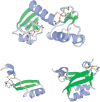Identification of a novel papillomavirus in oral swabs from giant pandas (Ailuropoda melanoleuca)
- PMID: 39830168
- PMCID: PMC11738909
- DOI: 10.3389/fvets.2024.1457471
Identification of a novel papillomavirus in oral swabs from giant pandas (Ailuropoda melanoleuca)
Abstract
To fully characterize papillomavirus diversity in giant pandas (Ailuropoda melanoleuca), we identified a novel papillomavirus (named AmPV5, GenBank accession number MZ357114) in oral swabs from giant pandas with the help of viral metagenomics technology in this study. The complete circular genome of AmPV5 is 7,935 bp in length, with a GC content of 39.1%. It encodes five early genes (E1, E2, E4, E6, and E7), two late genes (L1 and L2), and features conserved zinc-binding domains (CXXC- (X)28/29-CXXC) in E6 and E7 genes. E7 protein has an LxCxE domain (pRB binding) in its N-terminal region. The nucleotide sequence of AmPV5 L1 gene shares < 70% identity with other related sequences available in the GenBank database. Phylogenetic analysis indicated that AmPV5 fell within the Lambdapapillomavirus genus but formed a monophyletic branch away from other papillomaviruses found in Ailuropoda melanoleuca, Canis, Felis catus, Panthera uncia, Enhydra lutris, and Procyon lotor. According to the International Committee on Taxonomy of Viruses (ICTV) classification guidelines, AmPV5 is classified as a new species within the Lambdapapillomavirus genus. The discovery provides valuable insights into the viral diversity in giant pandas and highlights the need for continued surveillance of wildlife pathogens. Future studies should explore the potential role of AmPV5 in the health and disease ecology of this endangered species.
Keywords: giant panda; papillomavirus; phylogenetic analysis; viral metagenomics; virus genome.
Copyright © 2025 Zhao, Zhao and Zhang.
Conflict of interest statement
The authors declare that the research was conducted in the absence of any commercial or financial relationships that could be construed as a potential conflict of interest.
Figures




Similar articles
-
Virome comparisons in wild-diseased and healthy captive giant pandas.Microbiome. 2017 Aug 7;5(1):90. doi: 10.1186/s40168-017-0308-0. Microbiome. 2017. PMID: 28780905 Free PMC article.
-
Novel lambdapapillomavirus in northern sea otters Enhydra lutris kenyoni, associated with oral hyperplastic nodules.Dis Aquat Organ. 2024 Feb 29;157:73-80. doi: 10.3354/dao03771. Dis Aquat Organ. 2024. PMID: 38421009
-
Virome in Fecal Samples From Wild Giant Pandas (Ailuropoda Melanoleuca).Front Vet Sci. 2021 Nov 12;8:767494. doi: 10.3389/fvets.2021.767494. eCollection 2021. Front Vet Sci. 2021. PMID: 34869737 Free PMC article.
-
Review on parasites of wild and captive giant pandas (Ailuropoda melanoleuca): Diversity, disease and conservation impact.Int J Parasitol Parasites Wildl. 2020 Jul 28;13:38-45. doi: 10.1016/j.ijppaw.2020.07.007. eCollection 2020 Dec. Int J Parasitol Parasites Wildl. 2020. PMID: 32793415 Free PMC article. Review.
-
Synthesis of giant panda habitat suitability evaluations.Heliyon. 2024 Sep 4;10(17):e37398. doi: 10.1016/j.heliyon.2024.e37398. eCollection 2024 Sep 15. Heliyon. 2024. PMID: 39296247 Free PMC article. Review.
References
LinkOut - more resources
Full Text Sources
Miscellaneous

